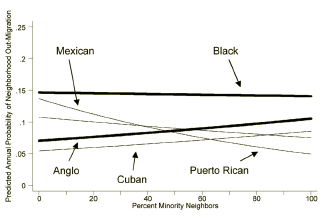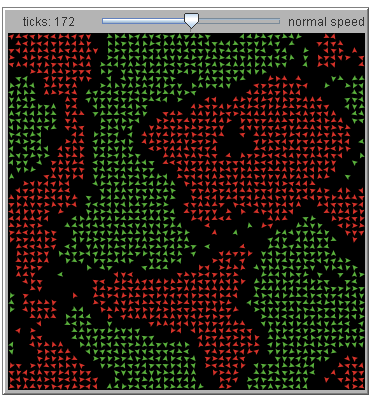Between 1969 and 1971, Tom Schelling, later my esteemed colleague at the University of Maryland, found that segregation results if people can move freely, even if they actually prefer a modest degree of diversity. For example, if everyone wants their children to attend schools that are racially diverse, but they would prefer their own race to be the majority, they will segregate into mono-racial schools. Similarly, if people prefer to live in politically vibrant communities where many opinions are held–but everyone prefers his own party to be the local majority–perfect partisan segregation will result.
You can test this pattern with a nice app by Uri Wilensky.* It distributes green and red turtles randomly in a “pond,” leaving some spaces open. You can set the turtles’ preference for the diversity of their immediate neighbors. Even if they prefer to sit among 25% turtles of the opposite color, they quickly sort into 99% homogeneous blocks, ringed by empty space. This is the result after the turtles have moved:
I showed this app to my students last Friday, but we also looked at an empirical study of Americans’ actual movement patterns in recent years.** This graph from Pais et al shows, for example, that a white family has about a 7% chance of moving in any given year if their neighbors are 100% white, rising to an 11% chance if their neighbors are 100% black. (The model controls for economics, crime, etc.)

On one hand, that’s not a very steep curve, and it doesn’t reflect deep racial animosity or aversion. On the other hand, a 4-point annual shift will quickly accumulate, especially since neighborhoods that start with any diversity are quite rare. This means that any integrated neighborhood, school, college, or workplace is endangered even if people prefer a degree of diversity.
*Wilensky, U. (1997). NetLogo Segregation model. http://ccl.northwestern.edu/netlogo/models/Segregation. Center for Connected Learning and Computer-Based Modeling, Northwestern University, Evanston, IL. ; Wilensky, U. (1999). NetLogo. http://ccl.northwestern.edu/netlogo/. Center for Connected Learning and Computer-Based Modeling, Northwestern University, Evanston, IL.
**Jeremy F. Pais, Scott South, and Kyle Crowder, “White Flight Revisited: A Multiethnic Perspective on Neighborhood Out-Migration,” Population Research Policy Review 2009 June 1; 28(3): 321–346.)

Pingback: why the Jews left Boston, why the Catholics stayed, and what that teaches us about organizing « Peter Levine
Pingback: organizing is renewable energy « Peter Levine